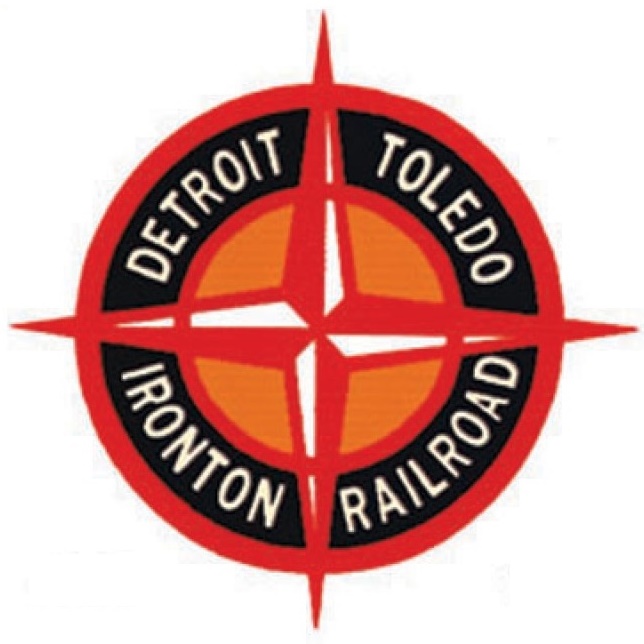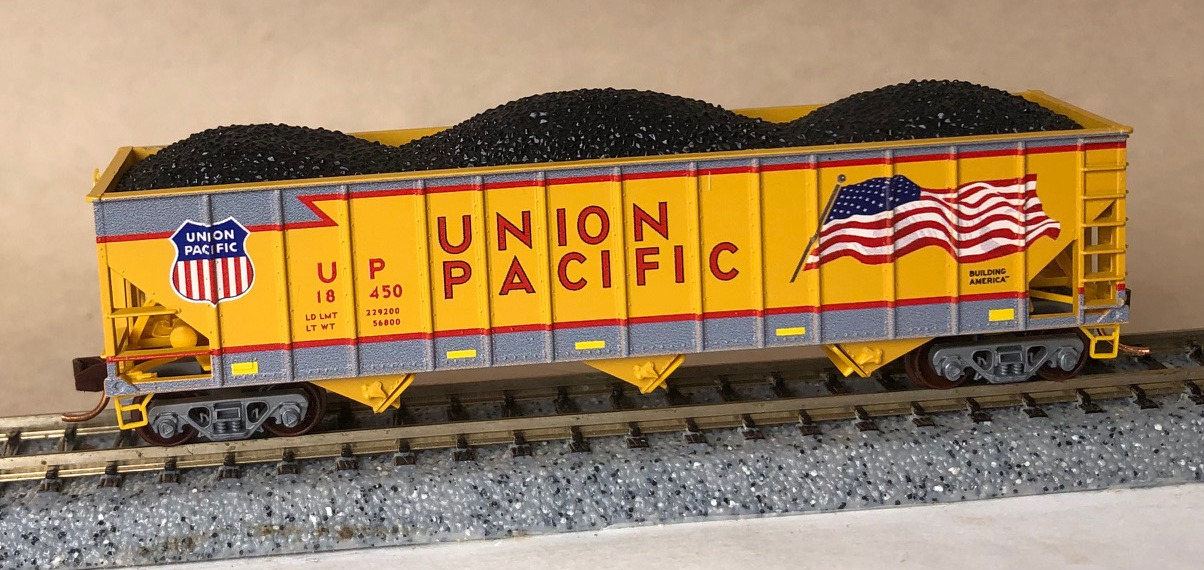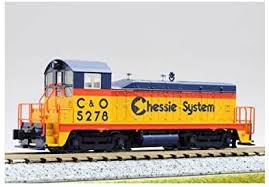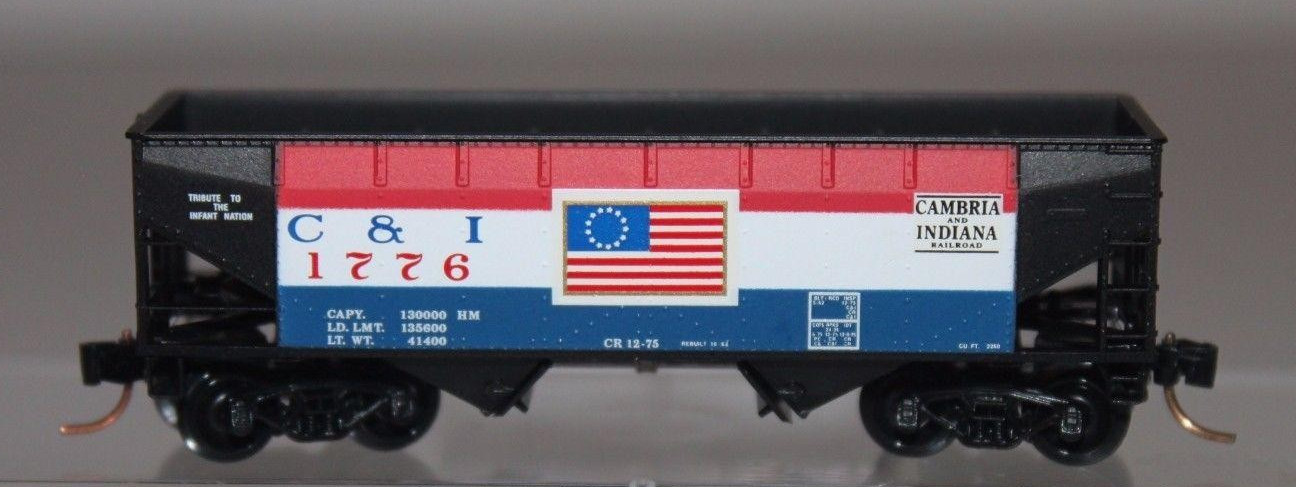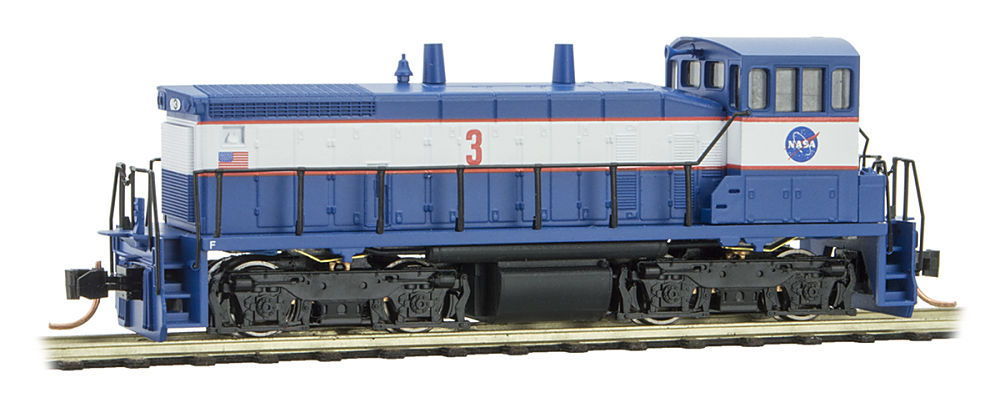Model Information: This model is one of Micro-Trains' earliest releases. It was first produced in 1975 with Dimensional Data, and the following year in several different paint schemes. It models a 50 foot steel gondola with a fishbelly and drop-ends. Note that many 3rd party loads designed for MTL's fix-end gondola will not fit in this model. What is cool is that the ends can actually be dropped! This feature makes this model unique among N Scale gondola toolings.
This model is equipped with National B-1 Trucks w. short extension (MTL 003 02 151 (1195)) and one end and w. medium extension on the other end.
This model is equipped with National B-1 Trucks w. short extension (MTL 003 02 151 (1195)) and one end and w. medium extension on the other end.
Prototype History: In US railroad terminology, a gondola is an open-topped rail vehicle used for transporting loose bulk materials. Because of their low side walls, gondolas are also suitable for the carriage of such high-density cargoes as steel plates, steel coils, and bulky items such as prefabricated sections of rail track. For weather-sensitive loads, these gondolas are often equipped with covers.
All-steel gondolas date back to the early part of the 20th century. However, most of the early ones were shorter and used 40' designs. The ubiquitous 50' steel gondola we see modeled so often today are typical of railcars produced since the end of the second world war. In the late 1940s, steel became once again readily available and new, longer gondolas were produced to transport material for America's booming economy. Generally, these 50 foot cars have a capacity of 70 tons and were actually 52'6" long. The first models of this design were produced by the Erie Railroad and the Greenville Steel Car Co, but nearly identical cars were produced by Pullman, ACF and Bethlehem.
All-steel gondolas date back to the early part of the 20th century. However, most of the early ones were shorter and used 40' designs. The ubiquitous 50' steel gondola we see modeled so often today are typical of railcars produced since the end of the second world war. In the late 1940s, steel became once again readily available and new, longer gondolas were produced to transport material for America's booming economy. Generally, these 50 foot cars have a capacity of 70 tons and were actually 52'6" long. The first models of this design were produced by the Erie Railroad and the Greenville Steel Car Co, but nearly identical cars were produced by Pullman, ACF and Bethlehem.
Road Name History: The DT&I was born in 1905 with the sale and reorganization of the Detroit Southern Railroad. Beginning in Detroit, the DT&I carved a huge northwest to southeast arc around western Ohio, serving Lima (like the bean, not Peru), Springfield, Jackson, and finally the Ohio River port of Ironton on the Kentucky border. Toledo was reached via a short segment of trackage rights on the Ann Arbor.
In 1920, as part of a complicated solution to realigning a shipping channel that served Henry Ford’s River Rouge plant, Ford bought the DT&I. The Ford years brought a ban on facial hair, uniform white hats and an expectation that crews keep their overalls clean and tidy. He also strung catenary and bought heavy electric locomotives for a 17 mile line segment between his River Rouge plant and Carolton, Michigan. During this period, the DT&I closed for business on Sundays. In 1929, Ford sold the line to Pennroad Corporation, a holding company affiliated with the Pennsylvania Railroad.
The steam fleet of the DT&I was a pretty homely lot. 2-8-0s and Russian Decapods were the kings of the road for the first few decades. As the tide of traffic turned from coal and minerals from the south end of the line to automobiles from the north end of the line, DT&I went to Lima Locomotive Works for faster stronger 2-8-4 Berkshires. Although the DT&I Berks were light and stumpy by Berkshire standards, they were a bit too much for DT&I’s physical plant so their final steam orders were for very heavy Mikados ( 20 tons heavier than USRA Heavy Mikes.) By 1955, they had completely dieselized with 37 EMD GP7’s and GP9’s setup for short hood forward operation (interesting given their ties to the Pennsylvania Railroad who preferred long hood forward operation) and 24 various EMD switchers.
The DT&I diesel fleet has always been solid orange but the logo on the long hood was smaller and more reserved in the 1950s. Second generation diesels included 8 GP35’s, 21 GP38’s, 6 GP40’s, 5 SD38’s (used in hump service,) 8 GP38-2’s, and 20 GP40-2’s. Features included a general lack of dynamic brakes and nose mounted gong style bells (a feature familiar to fans of Chicago & North Western.)
The freight car fleet was very, very colorful. Often, special colors were used to identify groups of cars for large customers. Ocean blue boxcars were for General Mills, Army green went to a paper mill on the Soo Line, yellow went to Campbell Soup, and of course, the auto parts cars which came in sky blue, cypress green, and magenta.
In 1963, and with control having been passed from Pennroad to The Pennsylvania Company (another holding company at arms length from the PRR,) the DT&I gained control of the Ann Arbor from their parent Wabash, turning the AA orange. This was part of the complicated arrangements made in the run up to the Penn Central merger. PRR needed to end their control of Wabash but wanted to hold onto DT&I and Ann Arbor. DT&I control ended in 1973 when AA declared bankruptcy.
In 1976, the DT&I was profitable even though parent Penn Central was in bankruptcy. Therefore DT&I was not included in the Conrail consolidation. In fact Conrail gave DT&I trackage rights on their lines from Springfield to Cincinnati, which gave DT&I even more Ohio River access as well as friendly connections with Southern and Louisville & Nashville. Meanwhile, The Pennsylvania Company, stripped of its Penn Central parent, put the DT&I up for sale. Grand Trunk Western offered to buy it and Chessie and N&W offered to jointly buy it. The ICC went with Grand Trunk Western and the sale was completed in 1980. Some locomotives were painted in GTW blue and red but with DT&I logos. In 1983, the DT&I officially merged into GTW.
In 1920, as part of a complicated solution to realigning a shipping channel that served Henry Ford’s River Rouge plant, Ford bought the DT&I. The Ford years brought a ban on facial hair, uniform white hats and an expectation that crews keep their overalls clean and tidy. He also strung catenary and bought heavy electric locomotives for a 17 mile line segment between his River Rouge plant and Carolton, Michigan. During this period, the DT&I closed for business on Sundays. In 1929, Ford sold the line to Pennroad Corporation, a holding company affiliated with the Pennsylvania Railroad.
The steam fleet of the DT&I was a pretty homely lot. 2-8-0s and Russian Decapods were the kings of the road for the first few decades. As the tide of traffic turned from coal and minerals from the south end of the line to automobiles from the north end of the line, DT&I went to Lima Locomotive Works for faster stronger 2-8-4 Berkshires. Although the DT&I Berks were light and stumpy by Berkshire standards, they were a bit too much for DT&I’s physical plant so their final steam orders were for very heavy Mikados ( 20 tons heavier than USRA Heavy Mikes.) By 1955, they had completely dieselized with 37 EMD GP7’s and GP9’s setup for short hood forward operation (interesting given their ties to the Pennsylvania Railroad who preferred long hood forward operation) and 24 various EMD switchers.
The DT&I diesel fleet has always been solid orange but the logo on the long hood was smaller and more reserved in the 1950s. Second generation diesels included 8 GP35’s, 21 GP38’s, 6 GP40’s, 5 SD38’s (used in hump service,) 8 GP38-2’s, and 20 GP40-2’s. Features included a general lack of dynamic brakes and nose mounted gong style bells (a feature familiar to fans of Chicago & North Western.)
The freight car fleet was very, very colorful. Often, special colors were used to identify groups of cars for large customers. Ocean blue boxcars were for General Mills, Army green went to a paper mill on the Soo Line, yellow went to Campbell Soup, and of course, the auto parts cars which came in sky blue, cypress green, and magenta.
In 1963, and with control having been passed from Pennroad to The Pennsylvania Company (another holding company at arms length from the PRR,) the DT&I gained control of the Ann Arbor from their parent Wabash, turning the AA orange. This was part of the complicated arrangements made in the run up to the Penn Central merger. PRR needed to end their control of Wabash but wanted to hold onto DT&I and Ann Arbor. DT&I control ended in 1973 when AA declared bankruptcy.
In 1976, the DT&I was profitable even though parent Penn Central was in bankruptcy. Therefore DT&I was not included in the Conrail consolidation. In fact Conrail gave DT&I trackage rights on their lines from Springfield to Cincinnati, which gave DT&I even more Ohio River access as well as friendly connections with Southern and Louisville & Nashville. Meanwhile, The Pennsylvania Company, stripped of its Penn Central parent, put the DT&I up for sale. Grand Trunk Western offered to buy it and Chessie and N&W offered to jointly buy it. The ICC went with Grand Trunk Western and the sale was completed in 1980. Some locomotives were painted in GTW blue and red but with DT&I logos. In 1983, the DT&I officially merged into GTW.
Brand/Importer Information: Micro-Trains is the brand name used by both Kadee Quality Products and Micro-Trains Line. For a history of the relationship between the brand and the two companies, please consult our Micro-Trains Collector's Guide.
Manufacturer Information:  Micro-Trains Line split off from Kadee Quality Products in 1990. Kadee Quality Products originally got involved in N-Scale by producing a scaled-down version of their successful HO Magne-Matic knuckle coupler system. This coupler was superior to the ubiquitous 'Rapido' style coupler due to two primary factors: superior realistic appearance and the ability to automatically uncouple when stopped over a magnet embedded in a section of track. The success of these couplers in N-Scale quickly translated to the production of trucks, wheels and in 1972 a release of ready-to-run box cars.
Micro-Trains Line split off from Kadee Quality Products in 1990. Kadee Quality Products originally got involved in N-Scale by producing a scaled-down version of their successful HO Magne-Matic knuckle coupler system. This coupler was superior to the ubiquitous 'Rapido' style coupler due to two primary factors: superior realistic appearance and the ability to automatically uncouple when stopped over a magnet embedded in a section of track. The success of these couplers in N-Scale quickly translated to the production of trucks, wheels and in 1972 a release of ready-to-run box cars.
Micro-Trains Line Co. split off from Kadee in 1990 to form a completely independent company. For this reason, products from this company can appear with labels from both enterprises. Due to the nature of production idiosyncrasies and various random factors, the rolling stock from Micro-Trains can have all sorts of interesting variations in both their packaging as well as the products themselves. When acquiring an MTL product it is very important to understand these important production variations that can greatly enhance (or decrease) the value of your purchase.
Please consult our Micro-Trains Collector's Guide

Micro-Trains Line Co. split off from Kadee in 1990 to form a completely independent company. For this reason, products from this company can appear with labels from both enterprises. Due to the nature of production idiosyncrasies and various random factors, the rolling stock from Micro-Trains can have all sorts of interesting variations in both their packaging as well as the products themselves. When acquiring an MTL product it is very important to understand these important production variations that can greatly enhance (or decrease) the value of your purchase.
Please consult our Micro-Trains Collector's Guide
Item created by: Lethe on 2015-05-31 17:46:30. Last edited by gdm on 2020-07-24 07:29:25
If you see errors or missing data in this entry, please feel free to log in and edit it. Anyone with a Gmail account can log in instantly.
If you see errors or missing data in this entry, please feel free to log in and edit it. Anyone with a Gmail account can log in instantly.



